RFID Technology Guide : An Overview

RFID Technology
- RFID is a wireless technology that uses radio waves to identify and track objects based on the tags attached to them.
- Technological advancements and cost reductions have widely adopted it, enhancing industries like retail, logistics, healthcare, and more.
RFID History
- RFID technology has roots dating back to the early 20th century, with significant developments in the 1970s.
- Its evolution through the decades has led to widespread adoption across various industries.
RFID technology benefits
- Efficiency and Accuracy: Automates tracking, improving speed and reducing errors.
- Visibility: Offers real-time data on assets.
- Cost Reduction: Automates processes, reducing labor costs.
- Security: enhances control and reduces theft.
- Consumer Engagement: Enhances shopping experiences with detailed product information.
Key Markets and Applications
Utilized in supply chain management, asset tracking, inventory management, healthcare, access control, and retail, among other fields.
Passive RFID Tags vs. Active RFID Tags
- Passive tags operate without a battery, powered by the reader’s signal, making them suitable for short-range applications.
- Active tags have an internal power source, enabling long-distance tracking.
RFID System Components
An RFID system consists of tags, readers, antennas, and a host system for data management.
RFID Working Mechanism
RFID Products and Types
Products vary from inlays and tags to hard tags, dual frequency tags, and sensor tags, tailored for different applications.
Frequency Bands and Differences
RFID tags operate at Low-Frequency (LF), High-Frequency (HF)/NFC, and Ultra-High-Frequency (UHF) bands, each with specific use cases and ranges.
NFC vs RFID
NFC is a subset of RFID with a focus on short-range communication, typically for secure transactions and data exchange.
Construction of an RFID Tag
Tags consist of multiple layers including an antenna, microchip, substrate, and sometimes an adhesive, encapsulation, or a face laminate for additional protection or functionality.
Selecting the Right RFID Inlay & Tag
Selection depends on factors like material, placement, environmental conditions, and reading requirements, emphasizing the importance of matching the tag to the application’s needs.
RFID vs Barcode
Compared to barcodes, RFID offers advantages in data capacity, reading speed and flexibility, accuracy, and security.
RFID and IoT Solutions
RFID technology integrates with IoT solutions, providing a framework for smart, connected systems that enhance data collection, analysis, and decision-making.
To truly grasp the transformative power of RFID technology and explore its potential to revolutionize inventory management, particularly within the context of armory or gun management systems, consider taking the next step with a hands-on demonstration. By booking a demo with Armory Master Pro, you’ll gain insights from experts who specialize in leveraging RFID for enhanced security, accuracy, and efficiency in armory management.
Why Book a Demo with Armory Master Pro?
- Expert Guidance: Learn directly from specialists who understand the nuances of RFID in armory management
- Custom Solutions: Discover how RFID technology can be tailored to meet the specific needs of your armory or gun inventory system.
- See RFID in Action: Witness firsthand the operational benefits and features of an RFID-equipped inventory management system.
- Ask Your Questions: Get answers to your specific queries and concerns about integrating RFID technology.
How RFID Supports Armory Management
- Make sure that only authorized personnel can securely monitor firearms and ammunition.
- Automatically track every item within the armory, reducing the risk of human error and improving inventory accuracy.
- Streamline check-in and check-out processes, making it easier and faster to manage armory assets.
- Easily generate reports for compliance purposes and gain insight into inventory trends and usage patterns.
